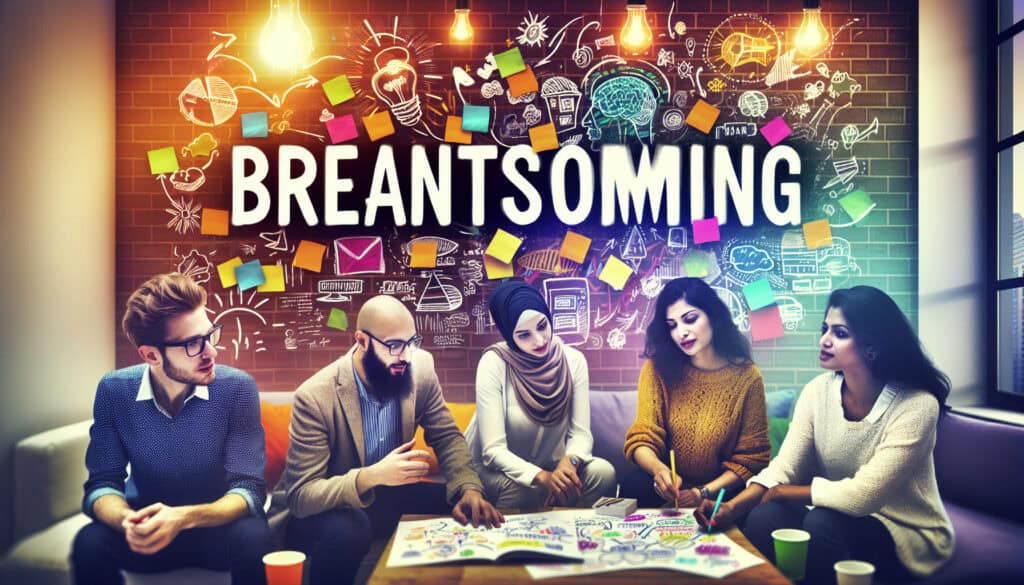A group creativity technique by which efforts are made to find a conclusion for a specific problem by gathering a list of ideas spontaneously contributed by its members.
- Methodologies: Customers & Marketing, Economics, Product Design
Brainstorming

Brainstorming
- Agile Methodology, Brainstorming, Creativity, Cross-Functional Collaboration, Design Thinking, Ideation, Innovation, Problem Solving Techniques, Teamwork
Objective:
How it’s used:
- Brainstorming sessions are typically unstructured and informal, and participants are encouraged to generate as many ideas as possible, without criticism or judgment.
Pros
- Can be a fun and engaging way to generate ideas, can lead to a large number of ideas in a short amount of time, and can be used to solve a wide range of problems.
Cons
- Can be dominated by a few vocal participants, can lead to a lot of ideas that are not relevant or feasible, and may not be suitable for all types of problems.
Categories:
- Ideation, Problem Solving
Best for:
- Generating a large number of ideas for a specific problem.
Brainstorming is widely utilized in various phases of product design, particularly during the ideation stage, where designers, engineers, and marketing teams collaborate to explore creative solutions for a given challenge. This informal approach thrives in industries such as technology, consumer products, automotive, and healthcare, where innovation is paramount for staying competitive. Typically, the initiative for a brainstorming session can be driven by project managers, design leads, or innovation officers, and often includes diverse participants like engineers, designers, researchers, and even customers to encourage a wide range of perspectives and expertise. Techniques such as mind mapping, round-robin sharing, or the ‘6-3-5’ method—where six participants generate three ideas each within five minutes—can further enhance idea generation. Brainstorming also allows for the rapid fusion of existing concepts into new products. The absence of judgment during sessions encourages bold thinking, which can be particularly beneficial when addressing complex design challenges or exploring novel technologies. Teams can document findings and prioritize ideas for further development or prototyping, supporting the iterative design process common in engineering and product development. Successful applications include everything from creating user-centered digital applications to innovating sustainable materials in manufacturing, demonstrating its versatility across various fields.
Key steps of this methodology
- Set a clear objective or problem statement for the session.
- Encourage unfiltered idea generation; all ideas should be voiced regardless of feasibility.
- Build on each other’s ideas; connect and elaborate on initial suggestions.
- Ensure equal participation from all members, encouraging quieter individuals to share.
- Utilize visual aids, such as sketches or mind maps, to represent ideas dynamically.
- Introduce prompts or stimuli to spark creative thinking when ideas stall.
- Keep the energy up; encourage enthusiasm and creativity throughout the session.
- Allow for spontaneous ideas and tangents that may lead to valuable insights.
Pro Tips
- Incorporate techniques like Round Robin and Brainwriting to ensure equal participation and prevent dominant voices from overshadowing quieter team members.
- Set specific time constraints for idea generation phases followed by relaxation periods to stimulate divergent thinking and avoid cognitive fatigue.
- Document all ideas visually using tools like mind maps or digital boards, fostering a collaborative atmosphere and enabling building upon others' contributions.
To read and compare several methodologies, we recommend the
> Extensive Methodologies Repository <
together with the 400+ other methodologies.
Your comments on this methodology or additional info are welcome on the comment section below ↓ , so as any engineering-related ideas or links.
Historical Context
1949
1950
1950
1960
1960
1960
1960
1940
1950
1950
1958
1960
1960
1960
1960
(if date is unknown or not relevant, e.g. "fluid mechanics", a rounded estimation of its notable emergence is provided)















Related Posts
Musculoskeletal Discomfort Questionnaires
Multivariate Testing (MVT)
Multiple Regression Analysis
Motion Capture Systems
MoSCoW Method
Mood’s Median Test